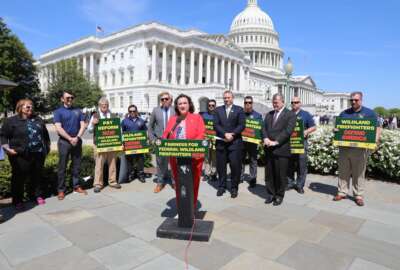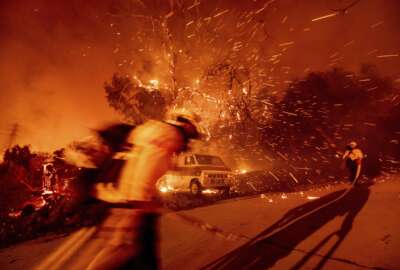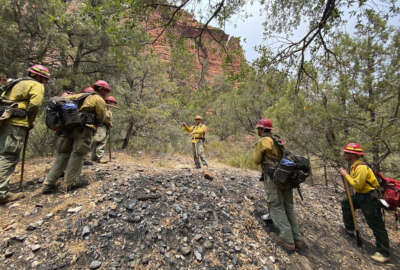
15 weeks until federal firefighters face ‘pay cliff,’ warn Forest Service, Interior officials
With an early start to wildfire season already underway, agency officials warn major attrition of federal wildland firefighters is coming, unless there are...
Federal wildland firefighters who combat dangerous wildfires, like the ones responsible for currently hazardous air conditions on the east coast, are facing yet another crisis.
Time is running out for a temporary pay raise for federal firefighters, officials at the Department of Interior and the Department of Agriculture’s Forest Service warned senators on the Energy and Natural Resources Committee.
The temporary pay raise, in an attempt to improve recruitment and retention, offered federal firefighters a boost of either $20,000 or 50% of their annual base salary, whichever number is lower. But the funding, part of the Infrastructure Investment and Jobs Act (IIJA), will run out by the end of September.
“The temporary pay increase has helped us retain some of our workforce, who might have left otherwise, and certainly has brought some new workers into our firefighting workforce,” Jaelith Hall-Rivera, the Forest Service’s deputy chief of state, private and tribal forestry, said at the committee hearing Thursday. “That’s why it’s absolutely critical that we avert the pay cliff and put something permanent into place.”
Interior and the Forest Service, the two agencies employing the vast majority of federal wildland firefighters, have spent years struggling with recruitment and retention of the frontline workforce. As wildfire seasons become longer and more intense, the workforce issues worsen even further.
Long hours, low pay, limited opportunities for career advancement and poor work-life balance are only the start of the challenges that federal firefighters face.
“Some firefighters are living out of their cars because they cannot afford housing. Duty stations that are more remote may not always provide easy access to basic services, such as grocery stores or even broadband coverage, which helps firefighters stay connected with their families while they’re away,” Government Accountability Office Director of Natural Resources and Environment Cardell Johnson said at the hearing.
In a 2022 GAO report, “low pay was cited as the top barrier [to recruitment and retention], despite federal actions to increase firefighter pay … Other industries, such as food service, offer equal or better pay for less dangerous work,” Johnson added.
While pay is the top workforce barrier, the challenge doesn’t exist in a vacuum, said Jeffrey Rupert, Interior’s director of the Office of Wildland Fire.
“These things are all interconnected, in terms of how we deal with the wildland firefighter workforce reforms — pay, capacity, mental health support, housing — all of it together is important,” Rupert said. “As we reduce the number of hours that we’re essentially requiring firefighters to work, we also have to have additional capacity to make up for those hours.”
The Biden administration, building on the efforts of the IIJA, proposed permanent reforms to increase federal and tribal firefighters’ pay, invest more in mental and physical health and wellbeing, improve housing options and expand the number of permanent firefighters. The proposals were included in the White House budget request for fiscal 2024.
Last month, bipartisan lawmakers also reintroduced the Wildland Firefighter Pay Parity and Classification Act, more commonly known as Tim’s Act, a bill that would permanently increase base pay for federal wildland firefighters and offer other benefits, such as more paid time off for rest and recuperation.
A group of senators called on the Homeland Security and Governmental Affairs Committee this week to take up the bill to offer a permanent pay raise, before the temporary funding expires in September.
Better career ladders for wildland firefighters
Along with the more immediate challenges, the Biden administration is also tackling long-term concerns. The Office of Personnel Management worked with agencies to develop a new occupational series last year, aiming to provide a clearer path for career advancement, specifically for wildland firefighters. But GAO’s Johnson said actually implementing the occupational series is the next step.
“It really is too early to determine the outcomes,” he said.
Implementation involves writing accurate, detailed position descriptions for each role that exists within the occupational series. Interior, which has roughly 5,000 wildland firefighters, has already started to use some of the new position descriptions.
“We still have additional work to do, especially as you get into some of the more specialized firefighting positions and the position descriptions that will go along with it,” Rupert told the committee. “But we have made real progress with developing position descriptions and have begun to implement the use of them.”
For the Forest Service, which employs more than 12,000 wildland firefighters, the work is slower-going.
“We have hundreds of position descriptions that could be going into this new series,” Hall-Rivera said. “We want to make sure that we build in time to get it right.”
Hall-Rivera said she expects the Forest Service to start making new hires within the updated classification system starting in calendar 2024.
Randy Erwin, president of the National Federation of Federal Employees, the union representing federal firefighters, said the bipartisan support from the Senate committee was promising for a potential continuation of the pay boost past September. But without a permanent solution, Erwin warned there will be a “mass exodus” of federal firefighters.
“We have 15 weeks left before the pay cuts kick in,” Erwin said in a statement. “The cut will devastate federal wildland fire services and it will take years to replace our highly trained fire professionals if we lose them to state and local departments that pay better and offer better work-life balance.”
Copyright © 2025 Federal News Network. All rights reserved. This website is not intended for users located within the European Economic Area.
Drew Friedman is a workforce, pay and benefits reporter for Federal News Network.
Follow @dfriedmanWFED





